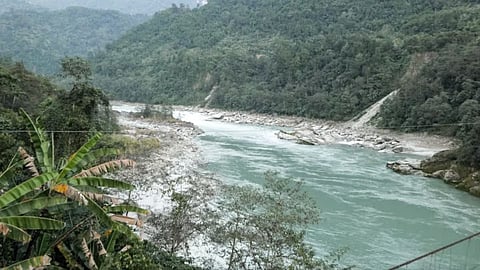
- Home
- Live Blog
- Breaking News
- Top Headlines
- Cities
- NE News
- Sentinel Media
- Sports
- Education
- Jobs

OUR CORRESPONDENT
ITANAGAR: Experts have clarified that the proposed Siang Upper Multipurpose Project (SUMP) in Arunachal Pradesh remains in the very early pre-feasibility report (PFR) stage, stressing that there is still a long way to go before any construction activity can be considered.
At a time when discussions around hydropower are growing across the state, they have underlined that the project is currently about study, dialogue, and long-term planning.
"The SUMP is not a reactionary move; it's a responsible one," said Teerath Singh Mehra, former Commissioner (Brahmaputra and Barak Wing) of the Union Jal Shakti Ministry.
"With about nine billion cubic metres of live storage capacity, the project provides more than half of the total flood storage required in the upper Brahmaputra basin. That alone shows its critical role in ensuring flood moderation, water security, and resilience," he observed.
Officials explained that the PFR is a desk-based assessment that relies on existing technical data such as river hydrology, flood behaviour, satellite imagery, and preliminary environmental indicators.
The aim is to evaluate whether the project is feasible enough to move to the detailed project report (DPR) stage, where intensive field investigations and public consultations would take place.
"The PFR serves to identify potential benefits, challenges, and alternatives so that the next stage, which is the DPR, can proceed with precision and full stakeholder awareness," said an NHPC official.
The PFR also involves broad consultations with state agencies and local institutions to gather early feedback. This ensures that social, cultural, and ecological sensitivities are recognized right from the beginning, the official said.
"Based on these insights, the PFR may suggest design modifications or even alternative project layouts before any field investigations begin. It's a process of refinement and responsibility, not execution," he added.
Former Member (Design & Research) of the Central Water Commission (CWC) and former Member (Hydro) of the Central Electricity Authority (CEA), N. K. Mathur, described the PFR as a "desk study."
"It helps assess whether a project is worth moving to the next level of detailed surveys, investigations, and public hearings. Only after a DPR is prepared, and clearances, power purchase agreements, and financial closures are in place, can a project even be considered for implementation," he pointed out.
NHPC officials recently briefed the Adi Baane Kebang (ABK) and the Siang Indigenous Farmers' Forum (SIFF), assuring that community engagement and transparency will guide every step forward - but only if the PFR results justify advancing to the DPR stage.
The ABK leadership has also emphasized the need for continued dialogue with project-affected families (PAFs) before any transition to DPR-related activities.
The SUMP is envisioned as a multipurpose storage project contributing significantly to flood moderation and hydropower generation in the Brahmaputra basin.
The CEA has estimated that over 80 per cent of India's untapped hydropower potential lies in this basin, spread across Arunachal Pradesh, Assam, Sikkim, Mizoram, Meghalaya, Manipur, Nagaland, and West Bengal, with Arunachal Pradesh alone contributing 52.2 GW.
The CEA has also prepared an Rs 6.4 trillion transmission blueprint to integrate over 76 GW of hydropower from the region by 2047.
Parallel assessments by the CWC warn of rising seasonal pressure on major river systems due to climate shifts and upstream interventions, reinforcing the need for carefully planned multipurpose storage infrastructure like SUMP to enhance water resilience without compromising ecological balance.
Prime Minister Narendra Modi, during his recent visit to Itanagar to lay the foundation stones of the Heo (240 MW) and Tato-I (186 MW) projects worth about Rs 3,700 crore, emphasized the government's commitment to strengthening border states.
Modi had stated that the nation earlier viewed these frontier regions as the "last villages", but now sees them as the "first villages", deserving priority development and national attention.
"The SUMP, at this stage, is not a matter of construction. It's a matter of careful planning, data-driven research, and sustained engagement with the people of Siang," the NHPC official added.
Also Read: Upper Siang Dam: India’s Strategic Shield & Development Engine